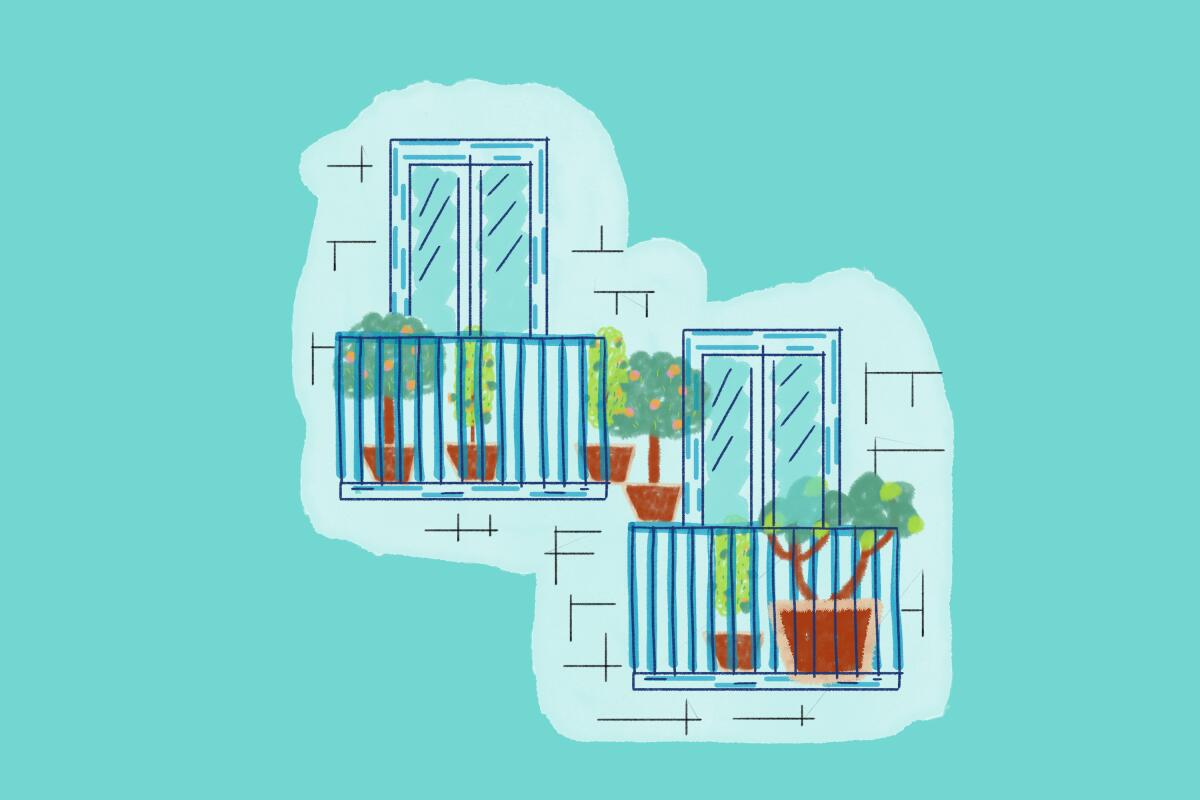Blueberries on your balcony: Your guide to growing fruit in pots

- Share via
This story is part of a package about growing food in containers. Here’s all you need to know, plus learn how to successfully grow vegetables and herbs in a contained space.
So you’ve always fantasized about roaming in your very own private orchard, munching a crisp apple while you search for luscious white-fleshed peaches or a handful of juicy Mexican limes for guacamole and mojitos.
Never mind that you probably couldn’t find all three ripe at the same time — this is a fantasy, remember? The reality is that you live in an urban apartment with only a balcony to your name.
You can grow food in pots on your balcony -- or anyplace else you get some sun. But there are important things to know about container farming. Consider this your starter guide.
Don’t despair! If you have a balcony patio or porch that gets at least six hours of full sun you can grow any number of fruit trees and berries as well, as long as you choose the right varieties, says Christy Wilhelmi, creator of the Gardenerd organic gardening website and author of the new book “Grow Your Own Mini Fruit Garden.”
First thing you need to know about growing fruit? Many fruit trees, including apples, pears and stone fruits such as peaches, nectarines, cherries, apricots and plums, need “chill” time during the winter to set fruit in the spring. These so-called chill hours are temperatures between 32 and 45 degrees Fahrenheit, Wilhelmi said, and during their dormancy period in the winter, many fruit varieties, including blueberries, require 600 to 1,200 chill hours to set fruit.
The problem is, we don’t get that many cold hours in Southern California, except maybe in mountain areas. “If you’re on the coast, you might get 160 to 480 hours tops, and inland, maybe around 500,” Wilhelmi said, “so it’s important to seek out low chill varieties bred to produce fruit with lower chill hours.” You can find this information in the fine print on labels.
You don’t need land to grow food. In our container farming series, these experts explain how to successfully grow veggies, fruit and herbs in containers on your patio, porch or balcony.
This doesn’t apply to all fruits, of course. Grapes have very low chill requirements, around 150 hours, according to the University of California Agriculture and Natural Resources, and subtropical fruits such as citrus, figs and avocados don’t have any chill requirements at all. In fact, these trees are actually cold tender, meaning they can be damaged or killed by frost (when temperatures dip down around freezing).
Second most important thing: Check the tag to be sure your tree is grafted onto a dwarf or ultra-dwarf rootstock, designed for small-space growing. (Again, check the labels.) Most fruit varieties grown in pots will be limited in size because the pots limit their growth, but dwarf rootstocks are designed to grow to a shorter height, say 6 to 8 feet tall, which makes them small enough to grow in large containers without affecting the size or health of the fruit.
What to plant? Ken Sparks, known as Farmer Ken Official on Instagram, a garden consultant and urban farmer, recommends several dwarf and ultra-dwarf varieties for their flavor, low chill hours and compact size, including an ultra-dwarf fig variety called Little Miss Figgy and a bush-sized avocado called Little Cado. For apples, he recommends dwarf varieties of Anna, Beverly Hills, Golden Dorset, Fuji and Pink Lady. For pears, Southern King or Hood; Panamint for nectarines; and for peaches, Florida Prince and Santa Barbara.
Why does it seem so hard to grow fresh herbs? Maybe you’re doing it wrong. We asked the experts for their secrets.
Wilhelmi recommends finding a nursery that specializes in fruit and fruit trees, or has staff with fruit-tree expertise, to get recommendations about the best varieties for your area. Sparks said he’s had good luck with mail orders, especially for citrus trees, from Four Winds Growers in Winters and Menlo Growers nursery in Gilroy.
Another resource we like? California Rare Fruit Growers, a nonprofit organization dedicated to all things fruit, lists more than 50 California nurseries that specialize in fruit trees and offers information about growing fruit, including this presentation by San Diego County arborist Tom Del Hotal, about growing fruit in small spaces.
Once you’ve figured out what you want to plant, Wilhemi and Sparks have a few more tips:
1. Watch the heat
Ideally, plant (or transplant) in the fall or early spring to give your plants time to adjust to their new surroundings and get firmly rooted before the stress of hot weather. In Southern California, you can find the best selection of fruit trees early in the year, around January or February. But you don’t have to wait. Sparks says he plants trees throughout the year. “I don’t recommend transplanting in intense heat, over 90 degrees, but if it’s mild you should be OK,” he said. “You just have to make sure with the watering that you keep the root ball from drying out. That’s the main thing.”
2. Go wide
Keep containers big for growing fruit, especially at the top. “The larger the better,” said Sparks. Even dwarf varieties need plenty of room for their roots, so start with a pot that is at least 20 to 24 inches wide and at least as tall. “Get as big a container as you can afford,” Wilhelmi says, to help keep the soil from drying out too quickly. And make sure the container is as wide or wider at the top as at the bottom, so you can easily pull the plant out of the pot later, when you need to repot, trim back old roots and/or add new soil.
These hikes showcase Southern California’s best ocean views, from Huntington Beach to Malibu
Wilhelmi likes terra cotta pots because they are handsome, porous and relatively inexpensive, but they also dry out faster than glazed pots because they are porous. Citruses have relatively shallow root systems for trees, she said, which makes them good choices for containers; just make sure you are choosing the right varieties for pots.
3. Water deep
Wilhelmi recommends a good soak once a week, or maybe twice a week during the hottest part of summer. That means watering slowly, to ensure all the soil is getting wet, until water starts coming from the bottom of the pot. Be sure you’re getting all the soil wet; sometimes soil will dry out and pull away from a pot, sending water down the sides of the pot and streaming out the bottom but never getting to the interior where the roots need it most.
Jo Anne Trigo, co-owner of Two Dog Organic Nursery, has a suggestion for watering acid-loving plants such as blueberries, which do best in containers anyway in Southern California, because it’s hard to keep enough acidity in our alkaline soil. She mixes 2 tablespoons of distilled white vinegar into a gallon of water and uses two of those to drench the soil of each of her blueberry bushes every two months. “It replaces the acid that gets watered away with our city water, which has a pH of 8,” she said. “Blueberries want a pH of 4.5 to 5.5, and after we started doing this, we had a remarkable resurgence of fruit on our bushes.”
4. Supplement the soil
Mix mycorrhizae fungi into your potting soil to help your trees develop strong roots. Most good, biodynamic potting soils include this beneficial organism, but if yours doesn’t, you can buy packets at most nurseries. And if you can afford only a basic potting soil (avoid brands that add chemical fertilizers to the soil), Wilhelmi said, try mixing in some compost, mycorrhizae and worm castings to help the soil “become biologically active and alive.”
Sparks said he adds worm castings as a top dressing to his trees as well. “I just sprinkle it over the top (of the soil) and lightly turn over the soil to incorporate it in.”
More to Read
Sign up for The Wild
We’ll help you find the best places to hike, bike and run, as well as the perfect silent spots for meditation and yoga.
You may occasionally receive promotional content from the Los Angeles Times.















